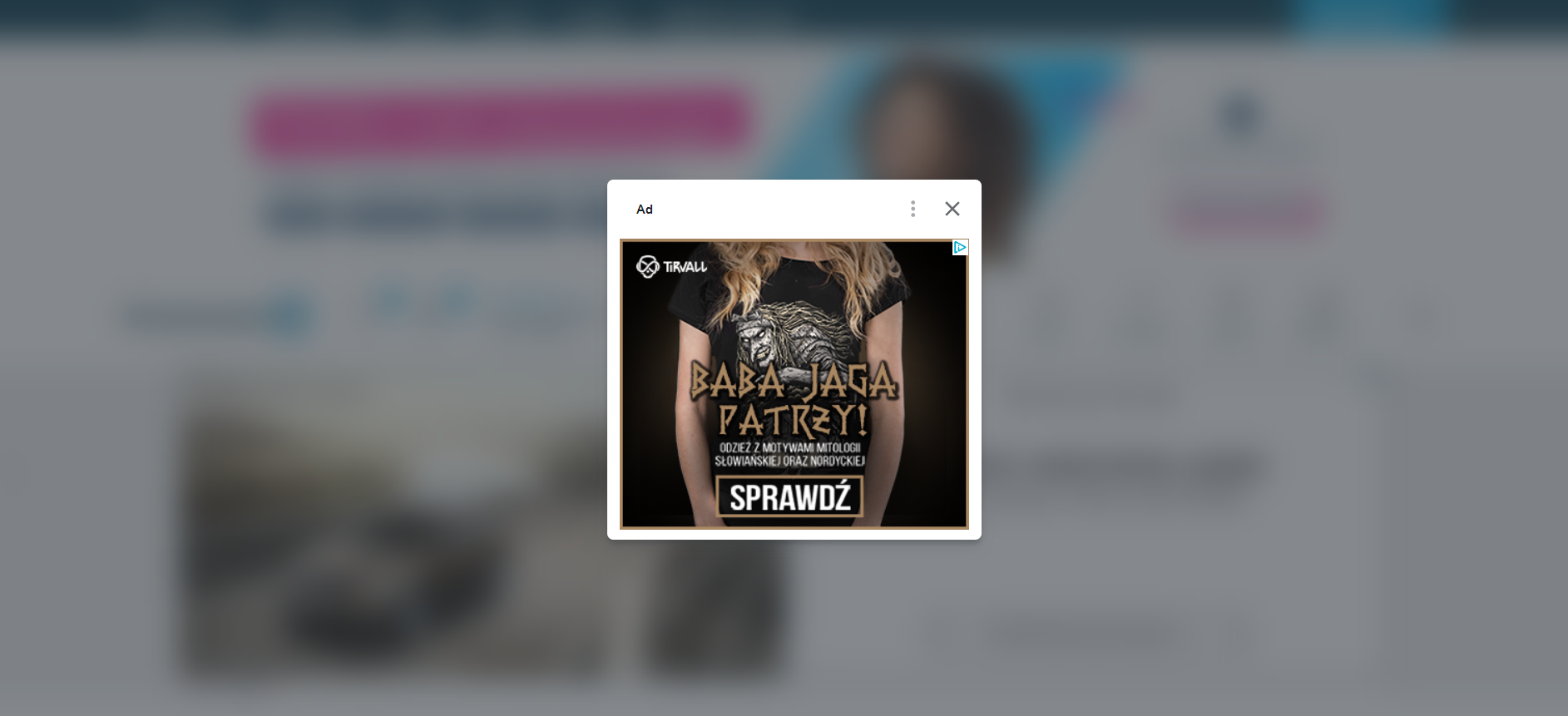
When mobile apps and website publishers aim to generate revenue from their platforms, the selection of ad formats becomes a critical decision. It can substantially impact UX, user engagement, and revenue generation. You can consider, for instance, Banner ads, Sticky, Native ones that cover only a portion of the interface, or you can opt for a full screen ad. Among the different ad formats available, Interstitial ads emerge as a particularly powerful tool, but their effectiveness depends on proper usage. If you want to know how not to cause poor User Experience while using Interstitial ads, what the best practices are, or how Interstitial ads work – just read along!
What are Interstitial ads?
Interstitial ads are full screen advertisements that cover almost the entire interface of mobile devices, tablets, and computers; they are typically displayed in mobile apps and are an excellent way to monetize your mobile site. Their most important feature is that they cover almost the whole screen of their host app or site, offering very good ad creation visibility. After seeing such advertisements, the user can either click on it and be redirected to the advertiser’s website or close it. You can implement this advertisement type using the three most important Google products for publishers: Google Ad Manager, AdMob, and AdSense (they are called Vignette ads on this platform). Interstitials come in various ad types, including:
- Static ads – that, for instance, can contain text, an image, and a CTA button (Call To Action) but don’t have interactive features or a video. While this kind of Interstitial ad might seem less effective than Interstitial video ads or audio ones, this isn’t usually the case. It all depends on the quality of the ad, copy, and visual aspects. Static ads typically let users close them right away;
- Rich media ads – that have a more engaging form, like an animation, video, audio, or even playable ad. In fact, mobile Interstitial ads are often implemented into gaming apps, where the user can play the advertised game before he has the chance to download it. This way, your app user can be entertained while waiting for the ad to end. Video ads, on the other hand, are a great way to convey more complex messages or even evoke emotions. Video ads often require users to watch them for a set period, usually around five seconds, before they can be closed.

How do Interstitial ads differ from Pop up ads?
To understand the difference between Pop up ads and Interstitials, it’s best to start with the definition of Pop ads (which aren’t Pop up ads). Basically, they appear on a web page, typically in a small window, new tab, or “on the top” of content. They are crafted to catch the user’s eye and encourage them to perform a particular action, like clicking on the ad. There are three forms in which a Pop ad can be displayed:
- Interstitial ads are full screen ads, particularly important in the case of mobile advertising, usually applied during various transition points in apps but also on websites. They appear “on top” of the content;
- Pop up ads – in contrast to Interstitials (which, as we mentioned, are full screen ads), they occupy only part of the screen and are shown in new windows. Importantly, it’s against Google policies to open Google ads in new windows, besides some world regions like China, where it’s more accepted by the user;
- Pop under ads – the main characteristic of this ad type is that it appear “under” the current web page in a new browser window or tab. Users typically only become aware of them after they have closed or minimized their current browser window. Implementing ads on sites containing this ad type is strictly prohibited by Google.
Mobile Interstitials
The optimal time to display Interstitial ads is during natural transition points or waiting times such as game level loading or the app load. Highly engaging and impossible to ignore, these ads are perfect for brand or product promotion, offering significant advantages that result in high profitability for advertisers and publishers. When placed correctly, they don’t harm the User Experience and bring high profits for publishers that opted for free mobile apps or decided to implement Interstitial ads on their websites.
Importantly, Google AdMob encourages app owners to implement Interstitial ads, but under some rules they provided. The company motivates to:
- Put them in moments where there is a natural transition, but at the same time, prevent them from being displayed at each touchpoint – one Interstitial ad once in a while is enough. Additionally, app developers should avoid implementing Interstitials after the break page, because adding them to such a point of the user journey may, for instance, raise the probability of accidental clicks;
- When it comes to word games, place Interstitial ads either at the beginning or the end of the game. In the case of games like music, simulation, or card ones, it’s better to install them at the contest transitions;
- Implement frequency capping, which is an automatic block you can set that prevents the same ad from being shown to a single person;
- Google specialists advise preloading an ad with the assistance of calling
loadAd()function beforeshow(). Adequate loading time is necessary if you don’t want to lower user retention. Latency caused by such an ad might result in the same outcomes as slow or unresponsive graphics that irritate users and, as a result, often make them leave earlier; - Avoid showing ads outside of your app. Such ads are called Outstitials, and they violate Google policies. For instance, you can’t display an ad after a user clicks a closing button.
Website Interstitials
It’s possible to integrate Interstitial ads on both mobile and desktop websites. As we established, a mobile web Interstitial is an ad that covers the entire screen of a website on a mobile device; similarly, a desktop web Interstitial appears on desktop versions of web pages. Google generally advocates for not much screen covering on websites. The company states that not all Interstitial content is bad, and it’s worth a shot applying it to mobile apps. It also highlights some other cases of Interstitials that are not ads that are acceptable for websites, like:
- Interstitials that are required for legal compliance, like the CMP (Consent Management Platform), which is essential for all websites with traffic from the European Union and shown after a user navigates to a site;
- Login dialogs, for example, an interstitial page for articles behind a paywall.
Although Google states that implementing Interstitial ads on websites can potentially lower Google search ranking, website owners should remember that there are many ranking factors. The most crucial one is that your site should provide valuable and original content to users.
Why use Interstitial ads?
- Interstitials are among the most effective ad formats available. This format boasts high visibility, and it makes it easier to encourage users to click on the CTA than, for instance, Banner ad type;
- Interstitials are highly sought after; their high Click Through Rates (CTRs) lead to increased ad revenue for publishers as they provide many benefits to advertisers;
- Displaying an Interstitial ad helps to enrich ad diversity, which helps to ensure more security as different ad formats might yield different profits depending on different circumstances like seasonality or existing trends. By using a variety of ad formats, publishers can develop a more enduring and impactful advertising environment;
- They rank among the most popular mobile ad formats, alongside Rewarded Video and regular Banner ads, which help to increase user engagement.
Interstitial drawbacks
- When placed incorrectly, Interstitial ads may end up surprising users instead of encouraging them to click on CTA;
- Most guidelines describe effective approaches for when a user scrolls within an app or navigates the website, but rarely do they describe what happens after clicking an ad. Clicked ads should lead a user to dedicated landing pages; otherwise, the user may feel he has been deceived. However, this depends solely on the advertisers, which is why it is worth collaborating with trusted monetization partners, who can limit the possibility of such situations;
- Implementation might be tricky – publishers have to know Google policies in order to not violate them. Again, preferably, this requires entrusting an external company with it;
- Some users perceive Interstitial ads as intrusive advertising; however, most app users and people searching and browsing the internet on their phones are already used to them. In fact, Google AdMob specialists encourage app developers to implement these ad types, but the company doesn’t fully approve website Interstitials.
How do Interstitials work?
If you are wondering what it takes to display Interstitial ads, here is what it looks like:
- When a user visits your website or app, an Interstitial ad request is sent to an ad exchange;
- After the ad exchange checks the screen size of the device the user is displaying the content on, the ad request will be sent to the advertisers;
- The bidding takes place, and the winning ad is displayed to the user after he clicks or switches between pages or views.
Interstitials examples & best practices
When starting out with Interstitials, it’s wise to follow a good example – for instance, a company that has been implementing this kind of ads for a long time and is a trusted Google Certified Publishing Partner, like optAd360! This is how interesting Interstitial ad examples from our network look like:


To reach the sweet spot between profits and user comfort, it is worth following these rules:
- Adhere to Google Ads Policies. For instance, during the test phase of building your app, you can only use test ads. Implementing production ads could result in the suspension of your account. What’s more, Interstitial should not appear immediately after a user visits your website;
- Remember about the possible outcomes of implementing too many ads, especially Interstitials, during one user visit. It may lead to banner blindness, which happens when users become too accustomed to digital ads – so much that their brains “filter them out” and, consequently, no longer see them. A remedy for this situation is frequency capping, which restricts the frequency of Interstitial ad displays to a user;
- Try to run a manual experiment in Google Ad Manager regarding web Interstitials. This is an effective way to check different settings in GAM and compare results afterward;
- Consider your user – your website or app should follow linear User Experiences – this comes down to creating the most simplified user flow and not bothering them. Nobody likes to be interrupted, and an ad appearing during some tasks may lead to user frustration. Another reason for not interrupting user activities is the high probability of accidental clicks. According to Google policies for publishers, creating an environment where they are possible is prohibited;
- If you monetize your app with Interstitials, stop audio output from your product while this kind of ad is displayed – this way, you won’t confuse your user.
Earn more with the help of monetization partner
Before implementing Interstitials, it’s important to consider their impact on User Experience. However, if you partner with a monetization partner like optAd360, you won’t have to worry about such issues! With the aid of our optAd360 AI Engine and solutions like Revenue Booster and Ad Mapper, the ad layout created for your digital content will yield substantial profits while not affecting users. Additionally, we will, of course, optimize Interstitial ads implemented on your site or your app. optAd360 is a balanced solution for all those who search for a monetization partner that can be trusted and get the job done – meaning we take care of optimizing your ad revenue! All you have to do before starting is check out our requirements and then complete the registration form.


